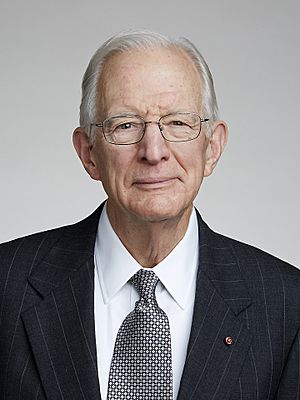John M. Hayes (scientist) facts for kids
Quick facts for kids
John M. Hayes
|
|
|---|---|

Hayes in 2016
|
|
| Born | September 6, 1940 Seattle, Washington, U.S.
|
| Died | February 3, 2017 (aged 76) Berkeley, California, U.S.
|
| Alma mater | |
| Awards |
|
| Scientific career | |
| Fields |
|
| Institutions |
|
| Thesis | Techniques for high resolution mass spectrometric analysis of organic constituents of terrestrial and extraterrestrial samples (1966) |
| Doctoral advisor | Klaus Biemann |
| Doctoral students |
|
| Other notable students | Daniel P. Schrag (post doc) |
John Michael Hayes (born September 6, 1940 – died February 3, 2017) was an American oceanographer. He was a scientist who studied the oceans and how living things interact with them. He worked at Indiana University Bloomington and the Woods Hole Oceanographic Institution in Woods Hole, Massachusetts.
Contents
Education and Early Research
John Hayes went to Iowa State University. He earned a degree in chemistry in 1962. After that, he studied analytical chemistry at the Massachusetts Institute of Technology (MIT).
In 1966, he earned his PhD from MIT. His research involved using a special tool called a mass spectrometer. He used it to study tiny parts of living things found on Earth and even from space. His professor, Klaus Biemann, guided his work.
Career and Important Discoveries
John Hayes was a professor at Indiana University Bloomington for 26 years. He taught in the chemistry and geology departments. Later, he moved to the Woods Hole Oceanographic Institution. He also worked at other famous universities like Harvard University.
Hayes made a very important discovery. He was the first to measure how different forms of carbon (called isotopes) are spread out in biolipids. Biolipids are like the fats and oils found in living things.
This new way of measuring helped scientists understand how carbon moves through nature. It showed how carbon travels in both modern environments and very old ones.
His studies on the carbon cycle also helped us learn about Earth's history. The carbon cycle explains how carbon moves between the air, oceans, land, and living things. His work gave clues about when important events happened, like when plants started making oxygen through photosynthesis. Photosynthesis is how plants use sunlight to make food and release oxygen.
Death
John Hayes passed away on February 3, 2017. He was 76 years old. He died at his home in Berkeley, California.
Awards and Recognition
John Hayes received many important awards for his scientific work.
- In 1997, he won the Urey Medal with another scientist, Geoffrey Eglinton.
- In 1998, he became a member of the National Academy of Sciences in the United States.
- He also received the Alfred E. Treibs Award in 1998.
- In 2002, he was given the V. M. Goldschmidt Award.
- In 2016, he was chosen as a Foreign Member of the Royal Society in the United Kingdom.
Legacy
To honor John Hayes, the Organic Geochemistry Division of the Geochemical Society created an annual award. Starting in 2019, this award is given to a scientist who has done great work combining different areas of science to advance biogeochemistry.

